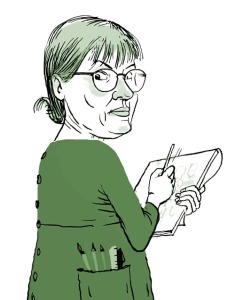Anyone who knows me well is aware that I've always been interested in cartoons and comics. As a child I devoured Asterix and Calvin and Hobbes; as a teenager I flipped to the political cartoons, studying Garrick Tremain's effortless shading; and today I consume pretty much any comics I get my hands on, online and off. I even (briefly) considered political cartooning as a career, before being dampened by the "death of printed media!" doom and gloom and the fact that all the political cartoonists I was aware of seemed to be older men. (No offence, Peter Bromhead.)
So with that in mind I was super excited to attend a session which featured not only Toby Morris (of Pencilsword fame) but also that rare unicorn, female cartoonist Sharon Murdoch! Interior designer and long-lived editorial cartoonist Peter Bromhead rounded off the panel, all facilitated by Toby Manhire.
What's your ambition in creating cartoons?
To do a drawing which the editor will accept. I look for the paradox which an event is all about; news is a sort of dung heap of information, and all I'm really interested in are the top two layers. I then sit around worrywarting it until I can do something which represents some kind of funny paradox. —Bromhead
Sometimes it's an act of solidarity, of protest, to show I've witnessed something. Witnessing can be very powerful; if enough people say they've seen something, that's a motivator for change. —Murdoch
Cartooning is a kind of preaching, agree or disagree?
I try not to, but it's something I have been accused of. I do try to say something with my comics, otherwise what's the point? Nowadays I'm not so interested in ripping someone to threads, I'm more interested in engaging with issues, talking about topics. Comics can be a medium for engagement and change. I don't feel duty-bound to be funny. —Morris
What Prime Minister do you most enjoy drawing?
Muldoon was easy. Just take a pear shape, add a straight line for the mouth, close one eye, add a bit of hair on top and there you go. —Bromhead
John Key is really challenging to draw, he has such an everyman face. I think Tom Scott comes closest: "He has a face that looks like a knife stabbed through a scrotum." —Sharon Murdoch
Just emphasise the white tide mark of his hair dye that goes up and down. Any man who dyes his hair is not to be trusted. —Bromhead
All three agreed that too much emphasis on technical proficiency can be stifling — it's more important to capture the idea, the energy of the person. Plus being too accurate can run the risk of attracting politicians into buying the originals, Bromhead's worst nightmare.
The death of printed media...?
I don't think cartoons are as important as they were in the 50s and 60s because we are so bombarded by visual images that cartoons don't seem to have the same impact anymore. I don't think people are reading newspapers, the political clout has waned. —Bromhead
I think cartoons are perfectly placed to succeed — with such short attention spans if you can communicate an idea in a picture that's a lot more effective. —Morris
I think the static image is still potent, will still survive the demise— sorry, I mean "the changing media landscape". I mean, look at the burkini cartoon by Anne Telnaes. So simple but very effective. —Murdoch
Personally I'm hopeful that political cartoons will continue to call out the baffling, upsetting and funny antics of our elected representatives.
Find their books in our catalogue:




Add a comment to: Giving Them Hell: Political Cartoons — WORD Christchurch